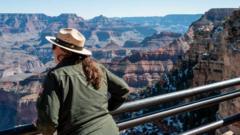Staff terminations in national parks and forests raise fears over visitor safety and ecosystem preservation.
**Backlash Grows Over Cuts to National Parks and Forest Services**

**Backlash Grows Over Cuts to National Parks and Forest Services**
Cuts to critical staff endanger public safety and conservation efforts, prompting public outrage.
The recent extensive cuts to staff at national parks, forests, and wildlife habitats, underscored by the Trump administration, have prompted significant backlash from the public and conservation advocates. These measures are leading to diminished public access and reduced conservation efforts in America’s cherished natural landscapes.
Visitors have already begun to feel the repercussions, including longer entrance lines, fewer operating hours at visitor centers, closed trails, and deteriorating public amenities. Employees are voicing their concerns about their future as well as the degradation of these essential outdoor spaces. For instance, Kate White, a wilderness ranger who usually carries out environmental clean-up tasks, has seen an alarming reduction in her team's capacity to maintain vital services, such as backcountry toilets in the snow-covered Enchantments of Washington.
“Without adequate maintenance, these crucial facilities could lead to severe ecological damage,” she warned, emphasizing her role in ensuring visitor safety in perilous conditions. Previously, she and her team interacted with thousands of park-goers, offering guidance and assistance. With the cuts now in effect, White fears the effects on public safety and the overall experience of park visitors, particularly with peak tourist seasons approaching.
The budget cuts have had a staggering impact on the National Park Service and the US Forest Service, with up to 5% of park staff—approximately 1,000 workers—dismissed. The Forest Service has been hit worse, losing about 10% of its workforce, or around 3,400 employees. This has led to significant management challenges at national parks, which welcome around 325 million visitors annually, and national forests serving nearly 159 million.
Reports indicate that lengthy car queues at parks, such as Grand Canyon National Park over the President's Day weekend, stemmed from staffing shortages. Signs of closure on a popular trail in Seattle cited these personnel cuts directly. In an act of protest at Yosemite National Park, some staff hung an upside-down American flag, symbolizing their opposition to the cuts.
Andria Townsend, previously a carnivore biologist at Yosemite, expressed her grave concerns over the future of endangered species she was engaged in protecting, following her recent job elimination. Longtime Forest Service employees Claire Thompson and Xander Demetrios emphasized their distress at being dismissed without proper recognition of the risks involved in their work.
Some staff have reportedly been rehired following public protests, with Interior Secretary Doug Burgum announcing plans to hire 5,000 seasonal workers during the warmer months. He acknowledged the public's pain concerning job losses but maintained that reducing the national deficit remains a priority for the administration.
Outdoor activists warn that those planning visits to national parks may encounter increased litter, fewer amenities, and overall lower expectations if these cuts remain in place. Preparations for maintaining trails and firefighting efforts are also jeopardized, raising alarms over safety measures as wildfire season approaches.
Efforts to justify the cuts, with claims suggesting billions saved in federal spending, have yet to present tangible evidence. As pressure mounts, it remains uncertain how America's national parks and forests will manage the escalating demands from millions of nature enthusiasts.






















